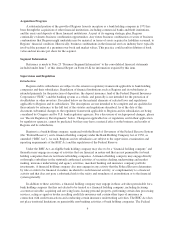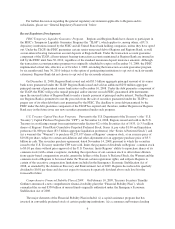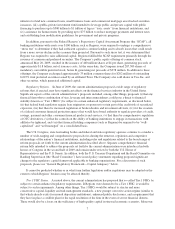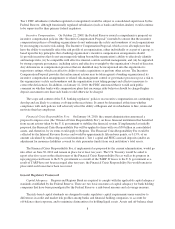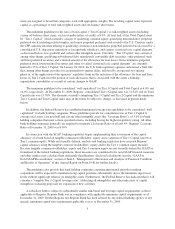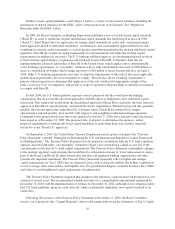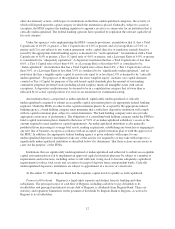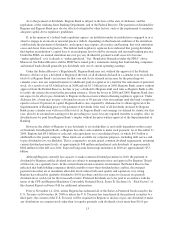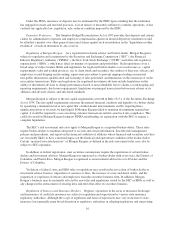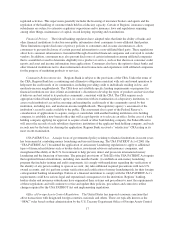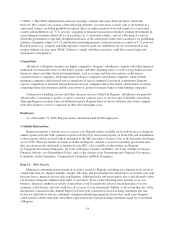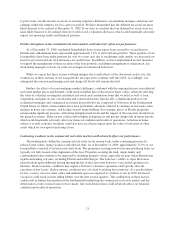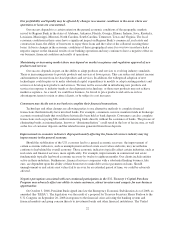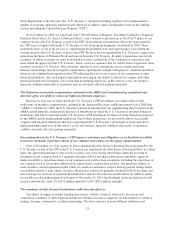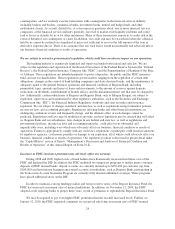Regions Bank 2009 Annual Report Download - page 28
Download and view the complete annual report
Please find page 28 of the 2009 Regions Bank annual report below. You can navigate through the pages in the report by either clicking on the pages listed below, or by using the keyword search tool below to find specific information within the annual report.share, as adjusted for any stock split, stock dividend, reverse stock split, reclassification or similar transaction,
(ii) dividends payable solely in shares of common stock and (iii) dividends or distributions of rights or junior
stock in connection with a stockholders’ rights plan. Regions has reduced its quarterly dividend to $0.01 per
share and does not expect to increase its quarterly dividend above such level for the foreseeable future.
Support of Subsidiary Banks. Under Federal Reserve policy, Regions is expected to act as a source of
financial strength to, and to commit resources to support, its subsidiary bank. This support may be required at
times when, absent such Federal Reserve policy, Regions may not be inclined to provide it. In addition, any
capital loans by a bank holding company to its subsidiary bank are subordinate in right of payment to deposits
and to certain other indebtedness of such subsidiary bank. In the event of a bank holding company’s bankruptcy,
any commitment by the bank holding company to a federal bank regulatory agency to maintain the capital of a
subsidiary bank will be assumed by the bankruptcy trustee and entitled to a priority of payment.
Cross-Guarantee Provisions. Each insured depository institution “controlled” (as defined in the BHC Act)
by the same bank holding company can be held liable to the FDIC for any loss incurred, or reasonably expected
to be incurred, by the FDIC due to the default of any other insured depository institution controlled by that
holding company and for any assistance provided by the FDIC to any of those banks that is in danger of default.
Such a “cross-guarantee” claim against a depository institution is generally superior in right of payment to claims
of the holding company and its affiliates against that depository institution. At this time, Regions Bank is the
only insured depository institution controlled by Regions for this purpose. If in the future, however, Regions
were to control other insured depository institutions, such cross-guarantee would apply to all such insured
depository institutions.
Transactions with Affiliates. There are various legal restrictions on the extent to which Regions and its
non-bank subsidiaries may borrow or otherwise obtain funding from Regions Bank. Under Sections 23A and 23B
of the Federal Reserve Act and the Federal Reserve’s Regulation W, Regions Bank (and its subsidiaries) may
only engage in lending and other “covered transactions” with non-bank and non-savings bank affiliates to the
following extent: (a) in the case of any single such affiliate, the aggregate amount of covered transactions of
Regions Bank and its subsidiaries may not exceed 10% of the capital stock and surplus of Regions Bank; and
(b) in the case of all affiliates, the aggregate amount of covered transactions of Regions Bank and its subsidiaries
may not exceed 20% of the capital stock and surplus of Regions Bank. Covered transactions also are subject to
certain collateralization requirements. “Covered transactions” are defined by statute to include a loan or
extension of credit, as well as a purchase of securities issued by an affiliate, a purchase of assets (unless
otherwise exempted by the Federal Reserve) from the affiliate, the acceptance of securities issued by the affiliate
as collateral for a loan, and the issuance of a guarantee, acceptance or letter of credit on behalf of an affiliate. All
covered transactions, including certain additional transactions (such as transactions with a third party in which an
affiliate has a financial interest), must be conducted on market terms.
FDIC Insurance Assessments. Regions Bank pays deposit insurance premiums to the FDIC based on an
assessment rate established by the FDIC. FDIC rates generally depend upon a combination of regulatory ratings
and financial ratios. Regulatory ratings reflect the applicable bank regulatory agency’s evaluation of the financial
institution’s capital, asset quality, management, earnings, liquidity and sensitivity to risk. On February 27, 2009,
the FDIC issued a final rule (the “New Assessments Rule”) modifying the risk-based assessment system. The
New Assessments Rule provides that the assessment rate for large institutions that have long-term debt issuer
ratings will be determined using a combination of the institution’s weighted average regulatory ratings, its long-
term debt issuer ratings and the institution’s financial ratios, each equally weighted. The New Assessments Rule
also introduced a new financial ratio into the relevant set of calculations that is intended to capture certain
brokered deposits (in excess of 10% of domestic deposits) that are used to fund rapid asset growth.
Initially, assessment rates for institutions that are in the lowest risk category, generally varied from five to
seven basis points per $100 of insured deposits. On December 16, 2008, however, the FDIC adopted a final rule,
effective as of January 1, 2009, increasing risk-based assessment rates uniformly by seven basis points (on an
annual basis) for the first quarter of 2009. The New Assessment Rule increases initial base assessment rates
14


